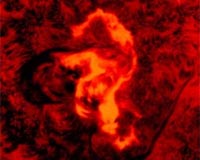 |
Bozeman MT (SPX) Jul 03, 2009 Three Montana State University instructors who want to help future scientists and engineers develop experiments for space recently launched experiments of their own. During a weeklong RockOn/RockSat workshop in Virginia, Ross Snider, Randy Larimer and Angela Des Jardins joined nearly 100 university instructors and students from 21 states who prepared experiments for flight. A rocket carrying their experiments was launched at 5:30 a.m. June 26 from NASA's Wallops Flight Facility in Virginia, reached an altitude of 73 miles, then returned to Earth where the experiments were recovered. Snider and Larimer work in MSU's Department of Electrical and Computer Engineering. Des Jardins is interim director of the Montana Space Grant Consortium, based at MSU. They attended the workshop to learn how to create future space payloads and involve students in building those payloads. Back at MSU, Snider works with Brock LaMeres and Todd Kaiser in the electrical and computer engineering department to figure out how to design computers that can tolerate radiation in space. Radiation levels in space are significantly higher than at sea level, so normally-configured computers can fail when they encounter such levels, Des Jardins said. The MSU researchers are trying to design a computer that can reconfigure itself at high levels of radiation. When levels decline, the processors will shut down to conserve power or will use the extra processors for other tasks. The RockOn/RockSat program was conducted in partnership with the Colorado and Virginia Space Grant Consortia with support from NASA. MSU's participants were sponsored by the Montana Space Grant Consortium. Share This Article With Planet Earth
Related Links MSGC Space Tourism, Space Transport and Space Exploration News
 Fake Astronaut Gets Hit By Artificial Solar Flare
Fake Astronaut Gets Hit By Artificial Solar FlareHuntsville AL (SPX) Jun 04, 2009 In 1972, Apollo astronauts narrowly escaped a potential catastrophe. On August 2nd of that year, a large and angry sunspot appeared and began to erupt, over and over again for more than a week, producing a record-setting fusillade of solar proton radiation. Only pure luck saved the day. The eruptions took place during the gap between Apollo 16 and 17 missions, so astronauts missed the storm. ... read more |
|
| The content herein, unless otherwise known to be public domain, are Copyright 1995-2009 - SpaceDaily. AFP and UPI Wire Stories are copyright Agence France-Presse and United Press International. ESA Portal Reports are copyright European Space Agency. All NASA sourced material is public domain. Additional copyrights may apply in whole or part to other bona fide parties. Advertising does not imply endorsement,agreement or approval of any opinions, statements or information provided by SpaceDaily on any Web page published or hosted by SpaceDaily. Privacy Statement |